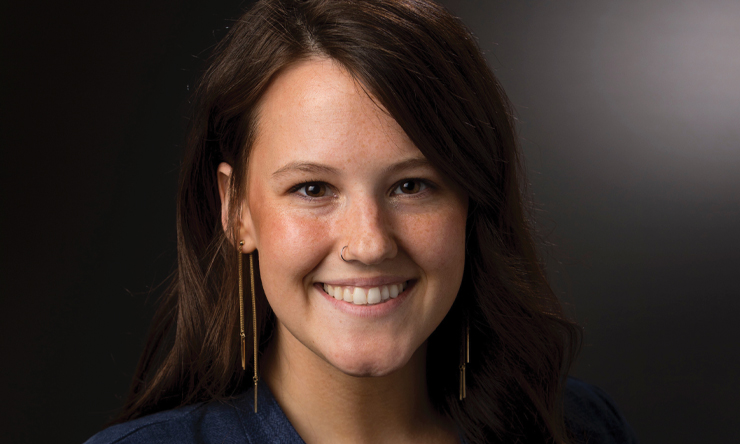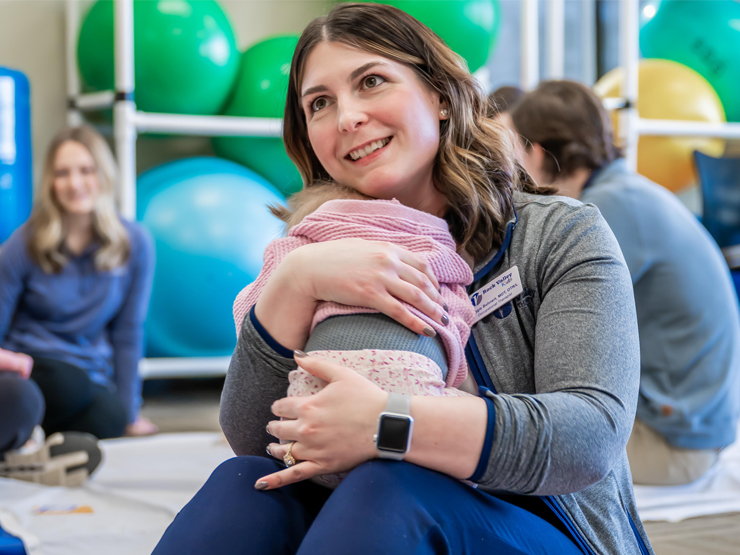On a raw, wet April morning, St. Ambrose sophomore Hannah Bridgewater knelt awkwardly on a muddy bank of Davenport's Duck Creek and began digging by hand through the soggy detritus of winter.
The hunter's prey? Slugs.
"I never in my life thought I'd be doing something like this," Bridgewater said.
Actually, few students likely do walk into the Biology 200 classes taught by Amy Blair, PhD, and Brenda Peters, PhD, expecting to establish a close working relationship with the terrestrial slug (Phylum: Mollusca, Class: Gastropoda.)
Yet several dozen such students annually move into more advanced science classes, better and wiser for the experience.
"I think they are intrigued by it," Peters, a professor, said of the slug-centered inquiry-based learning project that Blair, an assistant professor, helped introduce to the curriculum when she joined the department four years ago.
Blair had just completed post-doctoral research on slugs at Cornell University and suggested the creatures as a Biology 200 focus while interviewing for her SAU position. "A light bulb went off," Blair said. "They are easy to find and care for, and they lend themselves to interesting questions."
Educators elsewhere now may be taking interest. An article co-authored by Peters and Blair, "Terrestrial Slugs as a Model Organism for Inquiry-Based Experimentation in Majors General Biology Laboratory," will be featured on the August cover of The American Biology Teacher.
Although neither would deny they have become a bit slug-centric-Peters hit the brakes when she saw a lone slug traversing a bike path last fall and gave her husband cause for concern when she picked it up and packed it home-they also are proud to note this is a serious and potentially unique course of undergraduate study.
"Not every institution does the inquiry-based learning and, certainly, slugs are not well-studied," Peters explained. "There are a few biologists studying slugs. But to have undergraduates working with slugs, I would say that is fairly rare."
Of course, for slugs to be studied in a lab, they first have to be found.
And so, in April, Bridgewater and her classmates participated in what has become a rite of spring at St. Ambrose: students combing the banks of Duck Creek, as well as woods about a mile north of campus, all in search of slugs of varying shapes, sizes, species and genus.
The annual hunt follows some initial study of the creatures and the formation of work groups who plot the laboratory experimentation they will conduct based upon what they hope to learn.
Post-hunt, Bridgewater and first-year students Alex Meeske and Ethan Zahn spent the rest of the semester conducting research on the effects of light and dark on slugs when they eat. First-year student Chloe Whiteman and her group fed their slugs vegetation with varying levels of fructose to determine if the creatures prefer more or less sugar in their diet. Sophomore Natalie Woodhurst and first-year students Laura Bush and Collin Peterson planned to conduct their own light and dark experiment.
"We're curious about their vision," Bush explained. "They respond to light, but they live in the dark. We're wondering if that has anything to do with predation."
Clearly, Blair and Peters have accomplished something special. They have brought scholarly attention to an under-studied organism and simultaneously created hands-on teaching methods that have helped many groups of students share their excitement.
"Slugs have charisma," Peters declared, "and the students, believe it or not, actually become attached to the slugs. They get interested in these guys."
Yankee Doodle Slugs
From Puritans to the Beatles to zebra mussels, America has long contended with European invasions.
This is true of slugs, too; and where gardeners are concerned that's not good news.
SAU Professor of Biology Brenda Peters, PhD, said the European variety of slugs are very common now to the Midwest, and they are the hungry ones who wreak havoc on homegrown vegetation. The fungi-munching native slugs tend to hide away in dank, dark forests, she said.
So when first-year student Justin Keister found four all-American slugs from the family Philomycidae at Davenport's Junge Park in April, it was cause for a star-spangled celebration. "We were really excited," Peters said. "It's kind of a rare find."
Peters and Assistant Professor Amy Blair, PhD, hope to make it less rare. They plan to try breeding this American quartet in a Lewis Hall lab.
News
Share This Story



